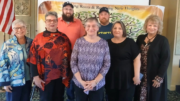“I wanted to make a film related to where I’ve lived for a while,” Currin said. “I did a lot of research about Alaskan myths and came across the otter man.”
Currin said the myth stood out, so he did more research on it, which led him to “The Strangest Story Ever Told.” Colp’s story recounts how one of his prospecting friends, named Charlie, encountered a swarm of the creatures in Thomas Bay.
“I read the book and really liked it, and wanted to make a short film based on the experience,” Currin said.
Colp first wrote about the creatures in 1900; his daughter Virginia published the story in book form in 1953.
The film is about 15 minutes long, has no dialogue and is shot in black and white in a tribute to the films of the early 1900s. An official one-minute trailer, which can be found at kushtakafilm.com, provides a foreboding musical track and plenty of up-close detail shots foreshadowing a less-than-desirable outcome.
The IMDB summary reads, “Based in the 1900s, a recently widowed prospector remains alone in the Alaskan wilderness during his desperate search for gold. Something has been stalking him from the trees. Can he find his fortune and leave Alaska for good, or will he lose the only real valuable thing he has left, his own life?”
Currin said his two actors are his wife Alicia Currin, as Margarette Driscoll, and Kodiak local Paul VanDyke, as Timothy Driscoll.
Among those helping with the production were Kodiak resident Robert Wagner, producer and a makeup artist; Nick Dunson, set decorator; Fred Martin, production assistant; and C.E. Zacherl, art director and concept artist.
“A lot of people who helped were just co-workers or Coasties like me,” he said.
VanDyke said his experience participating in the film was positive.
“It was the first time I ever shot a film with someone else directing,” VanDyke said. “Taking direction from a director was a new but good experience.”
VanDyke said the teamwork with involved with the small crew was what made everything special.
“Cam is a great director and we have a solid team, so that’s what made it special for me,” VanDyke said. “The guys that were helping with the behind the scenes stuff were a lot of fun to work with.”
VanDyke added that the black and white format brings something different to the table, beyond saving money.
“I like it because it puts the movie more into the film’s period — it’s more like an old-time movie and it fits because it’s a piece period,” VanDyke said. “I also think from a cinematic perspective it reduces some distraction of color and makes you focus on what is happening on the screen.”
Currin has some background in drama, having acted in middle school and high school. However, his experience in film was initially limited to playing around with amateur video making.
“I’ve always been attached to that creative outlet,” he said. “This is my first film to professionally make. I realized if I wanted to make films, I should start with a short.”
He added that he’s always been a movie buff with a soft spot for horror and science fiction films.
“I used to watch a lot of the old SciFi Channel and the horror movies on it like ‘Alien’ and ‘Gremlins,'” Currin said. “Movies like that were the golden age of sci-fi horror.”
The film took two years to plan, two months of prep work and a roughly a month to film and produce, with most of the crew volunteering.
Production and filming were done between November and December. The team faced a number of memorable obstacles — including the Nov. 30 earthquake on the first day of filming.
“That was the day when we first wanted to shoot and then we had that tsunami scare,” Currin said. “Luckily, nothing bad happened.”
Then, there was the challenge of shooting in a Kodiak winter.
“There were a few times when it snowed and we didn’t account for it, as flurries came into the shot,” Currin said.
“It did work out toward the end because the snow was intended for the final scene,” he said. “Having all that scenery from Kodiak makes it beautiful and stand out.”
In the end, he said the challenges were worth it.
“I always wanted to do it, and now it’s down,” Currin said. “It’s going to be really cool to see that work come to a close.”
Currin said he financed the film out of his own pocket, with a budget of approximately $10,000.
Now, he’s in the process of starting a crowdfunding campaign to help cover some additional costs. In addition, he said he’s trying to arrange a local showing but said those plans are still up in the air.
“I’m not asking for much, just enough to ship off to film festivals,” he said.
The campaign kicks off on Jan. 15 and will run for 40 days. He said donors will be recognized.
“I still have some room in the credits for backers,” Currin said. “We have a process that if you contribute you get your name in the credits.”
For more information on the movie, visit kushtakafilm.com.






































